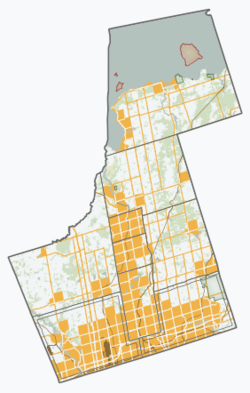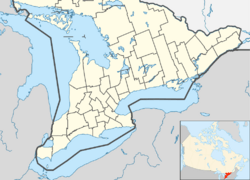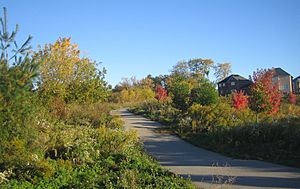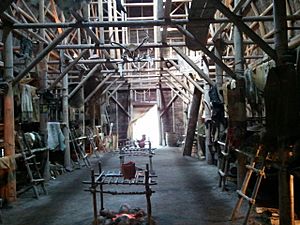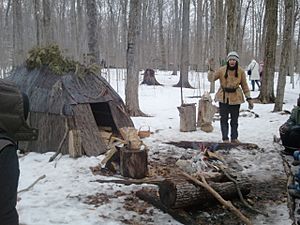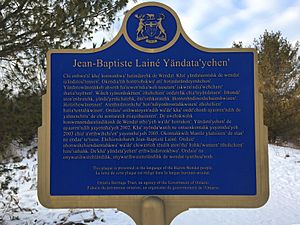Mantle Site facts for kids

View of the site looking west from Byers Pond Way.
|
|
| Location | Whitchurch–Stouffville, Regional Municipality of York, Ontario, Canada |
|---|---|
| Region | Regional Municipality of York, Ontario |
| Coordinates | 43°57′49″N 79°14′13″W / 43.96361°N 79.23694°W |
| History | |
| Periods | Late Precontact Period, ca. 1500–1530 |
| Cultures | Huron (Wendat) |
| Site notes | |
| Excavation dates | 2003-2005 |
The Mantle Site, also known as the "Jean-Baptiste Lainé" site, is a very old village site in Whitchurch–Stouffville, Ontario, Canada. It is located northeast of Toronto. This site is the largest and most complex village of the ancestral Wendat-Huron people found so far in the Lower Great Lakes area.
Scientists first thought the village was active between 1500 and 1530. However, new scientific tests show it was likely used from 1587 to 1623. This new information helps us understand how different Iroquoian groups moved and lived in the region before the Wyandot nation fully formed.
Contents
Discovering the Ancient Village
In 2002, workers found the remains of an old Huron village. This happened during construction of a new housing area in Whitchurch–Stouffville. The village was located along Stouffville Creek, which flows into West Duffins Creek. This discovery was made just before Europeans started exploring the Great Lakes region.
Life in the Mantle Village
Around 1587 to 1623, about 1500 to 2000 people lived in this 4.2-hectare (10-acre) village. It is believed that people from several smaller villages, like the Draper Site (five kilometres southeast), came together to form this community.
The Mantle Site was protected by a strong wooden fence, called a palisade, which had three rows. Inside, there were 95 longhouses. At any one time, about 50 of these longhouses were being used.
Each longhouse was about 20 feet (6.1 m) wide and 20 feet (6.1 m) high. Their lengths varied a lot, from 40 feet (12 m) to 160 feet (49 m). A typical longhouse was about 100 feet (30 m) long. They were built from maple or cedar saplings and covered with elm or cedar bark. The village was very well organized, with an open plaza and a system for managing waste.
The community needed more than sixty thousand young trees to build houses and palisade walls. Their farms would have covered hundreds, or even thousands, of hectares. ... It seems that trash was moved out of the village and into a ditch outside the palisade. This shows one of the first known systems for managing organic and inorganic waste in the northeast.
What They Ate and Wore
Corn made up 62% of the villagers' diet. This means each person ate about one pound of corn every day. The whole community needed at least 1,500 pounds of corn daily. They might have needed even more corn for trading with the Algonquin people to the north.
The community farmed 8 km2 (2,000 acres) of land, stretching up to 5 km (3.1 mi) in every direction from the village. For clothing, they needed up to 6,800 deer skins each year. This meant hunting in an area at least 40 km (25 mi) in every direction from the site.
Special Discoveries
In 2012, archaeologists found an iron axe from Europe. It was carefully buried in a longhouse at the center of the village. Experts believe the axe came from Basque whale hunters far away in the Strait of Belle Isle (in Newfoundland and Labrador). It was traded into the continent about a century before Europeans explored the Great Lakes. This axe is the earliest European iron item ever found in the North American interior.
Archaeologists also found ceramic pots shaped like humans and animals. These are similar to pots found in Oneida villages in New York State. This shows that the Mantle Site community had connections with many different groups. The human-like figures are thought to represent mythical corn husk people, linked to their farm crops.
Why Mantle Site is Special
Unlike other ancient villages in the Great Lakes area, the Mantle Site is unique. It was a place where people from several different villages came together to build a new home. During its time, it was the only village near the eastern Rouge trail, which connected Lake Ontario and Lake Simcoe.
Artifacts found at the site show that the villagers traded and interacted with First Nations groups from all directions: north, east, south, and west.
After living at the Mantle Site for two or three decades, the people left in the first half of the 16th century. They likely moved about five kilometers northwest to the Ratcliff Site or the Aurora Site. Later, in the 17th century, this community probably joined others to form one of the Huron tribes in the Orillia-Georgian Bay area.
Studying the Site and Artifacts
When the Mantle Site was discovered, experts from Archaeological Services Inc. were hired to study how important it was. They decided to save about 5% of the original site, mainly along the creek bank.
The site was carefully recorded, and over 150,000 artifacts were removed. These items are now being studied at McMaster University and the University of Toronto. Because they are so important to Canada's history, the artifacts will be kept safe by the Canadian Museum of Civilization. The archaeological work at the site took three years, from 2003 to 2005.
What Happened to the Site Later
Most of the Mantle Site is now used as a storm water pond. Some homes on the southwest corner of Lost Pond Crescent also sit on part of the old village. A small cemetery found outside the village walls has been protected. This was done following laws and with the help of First Nations communities.
The development of the area around James Ratcliff Avenue was delayed because of the site. An ossuary, which is a mass burial site, was expected to be found with 300 to 400 human remains. However, it has not been located yet. The Town of Whitchurch–Stouffville plans more housing development just south of the Mantle Site.
In 2004, First Nations people visited the site and held special ceremonies. The Mantle Site is important because it highlights the significance of ancestral burial sites to First Nations people. These sites are often protected by First Nations to prevent them from being disturbed.
Recognizing the Mantle Site
In 2007, the Town Council of Whitchurch–Stouffville officially recognized the Mantle Site. They called it "one of the most significant Huron ancestral villages in Southern Ontario." The town also promised to work with the Huron to give Indigenous names to local rivers, streets, and trails.
In 2011, the York Region District School Board announced that a new school next to the site would be named "Wendat Village Public School."
In the summer of 2011, Wendat ceremonies were held at the site. It was renamed the "Jean-Baptiste Lainé" Site. This was to honor a Huron-Wendat veteran who was recognized for his service in the Second World War.
In 2017, the Ontario Heritage Trust placed historical plaques near the Wendat Village Public School. These plaques tell the story and importance of the Jean-Baptiste Lainé Site. They explain the wide trading network of the villagers and how this 16th-century community helped form the Huron-Wendat people. The plaque is written in English, French, and Wendat, which is an Iroquoian language.
The Wendat People Today
The Huron (Wendat) are part of the larger Iroquoian cultural and language family. Today, the Huron-Wendat Nation is a First Nation community with reserves in Wendake, Quebec.
The Huron and other local First Nations have asked towns and developers in York Region to protect Indigenous sites. They want to be able to "worship at the places where [their] ancestors are buried." The discovery of the 16th-century European axe at Mantle is also important for the Wendat First Nation. It helps them in their discussions with the Canadian federal and provincial governments.
Film and Television About the Site
In 2012, a two-hour documentary film called Curse of the Axe was made about the Mantle Wendat-Huron Village Site. It was produced by yap films and Shaw Media, and narrated by Robbie Robertson.


